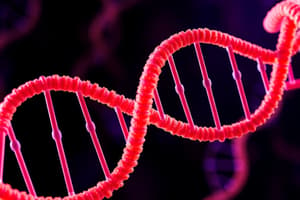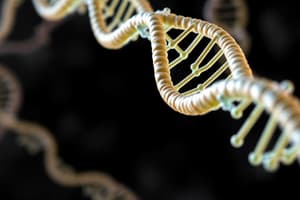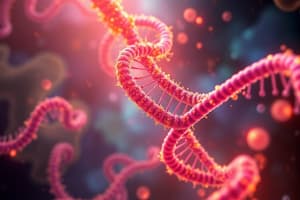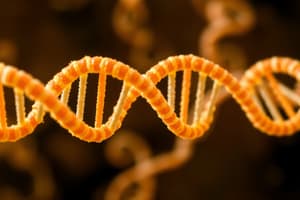Podcast
Questions and Answers
What is the role of RNA polymerase in transcription?
What is the role of RNA polymerase in transcription?
- It attaches free-floating RNA nucleotides to DNA bases.
- It forms covalent bonds between sugars and phosphates on the mRNA strand.
- It breaks hydrogen bonds between DNA base pairs.
- It guides transcription by reading the DNA code. (correct)
What is the difference between a codon and an anticodon?
What is the difference between a codon and an anticodon?
- A codon is a sequence of three mRNA nucleotides, while an anticodon is a sequence of three amino acids.
- A codon is a sequence of three tRNA nucleotides, while an anticodon is a sequence of three mRNA nucleotides.
- A codon is a sequence of three amino acids, while an anticodon is a sequence of three mRNA nucleotides.
- A codon is a sequence of three mRNA nucleotides, while an anticodon is a sequence of three tRNA nucleotides. (correct)
Which of the following correctly describes the pairing of bases during transcription?
Which of the following correctly describes the pairing of bases during transcription?
- Adenine (A) pairs with Uracil (U), Thymine (T) pairs with Adenine (A), Cytosine (C) pairs with Guanine (G).
- Adenine (A) pairs with Uracil (U), Cytosine (C) pairs with Guanine (G). (correct)
- Adenine (A) pairs with Thymine (T), Cytosine (C) pairs with Guanine (G), Uracil (U) pairs with Adenine (A).
- Adenine (A) pairs with Thymine (T), Cytosine (C) pairs with Guanine (G).
What is the role of ribosomes in translation?
What is the role of ribosomes in translation?
Which of the following is NOT a stop codon?
Which of the following is NOT a stop codon?
What is the process by which mRNA is synthesized from DNA called?
What is the process by which mRNA is synthesized from DNA called?
What is the name of the bond that forms between amino acids to create a protein?
What is the name of the bond that forms between amino acids to create a protein?
Which of the following correctly describes the difference between DNA and RNA?
Which of the following correctly describes the difference between DNA and RNA?
Flashcards
Transcription
Transcription
The process of making mRNA from DNA that occurs in the nucleus.
Translation
Translation
Using mRNA to synthesize proteins at the ribosomes.
mRNA
mRNA
Messenger RNA, which carries genetic information from DNA to ribosomes.
Codon
Codon
Signup and view all the flashcards
Anticodon
Anticodon
Signup and view all the flashcards
Start Codon
Start Codon
Signup and view all the flashcards
Stop Codons
Stop Codons
Signup and view all the flashcards
Peptide Bond
Peptide Bond
Signup and view all the flashcards
Study Notes
Protein Synthesis Overview
- Protein synthesis is a two-part process: transcription and translation
- The process ensures the correct protein is made from a DNA strand
- Requires understanding of DNA and RNA
- Location of transcription and translation are important
- Steps of transcription and translation must be known
Transcription
- Making mRNA from DNA
- Occurs in the nucleus
- DNA "unzips"
- RNA polymerase breaks hydrogen bonds between base pairs
- Free-floating RNA nucleotides attach to DNA bases on one side of the DNA molecule
- Covalent bonds form between sugars and phosphates on the mRNA strand
- mRNA molecule is released, and DNA "zips" back up
RNA vs DNA
- DNA contains thymine, RNA uses uracil instead
- DNA is double stranded, RNA is single stranded
- DNA uses deoxyribose sugar, RNA uses ribose sugar
- DNA stays in the nucleus, RNA moves between the nucleus and cytoplasm
- DNA has one type, RNA has three types (mRNA, tRNA, and rRNA)
Translation
- Using mRNA to make proteins
- Occurs at ribosomes
- mRNA leaves the nucleus and travels to a ribosome
- Amino acids are brought to the ribosome by tRNA
- tRNA bases (anticodons) pair with mRNA bases (codons)
- Amino acids join together by a peptide bond to form a protein (polypeptide)
Translation - Important Terms
- Proteins are made of amino acids
- The order of bases in mRNA determines which amino acids are added
- 3 mRNA nucleotides (or bases) code for a codon
- 3 tRNA nucleotides (or bases) code for an anticodon
- Three bases code for one amino acid
- Anticodons are specific, each tRNA carries a specific amino acid
- Start codon (AUG) = methionine - causes ribosomes to start translation
- Stop codons (UAA, UAG, or UGA) = causes ribosomes to stop translation
RNA Importance
- mRNA takes the code from DNA to the ribosome
- tRNA brings amino acids to the ribosomes to make proteins
- Information is transferred from DNA to RNA to proteins (central dogma of molecular biology)
Additional Notes
- A codon wheel can be used to determine the amino acid corresponding to a specific mRNA codon.
- Study the diagrams for a visual representation of the processes.
Studying That Suits You
Use AI to generate personalized quizzes and flashcards to suit your learning preferences.





